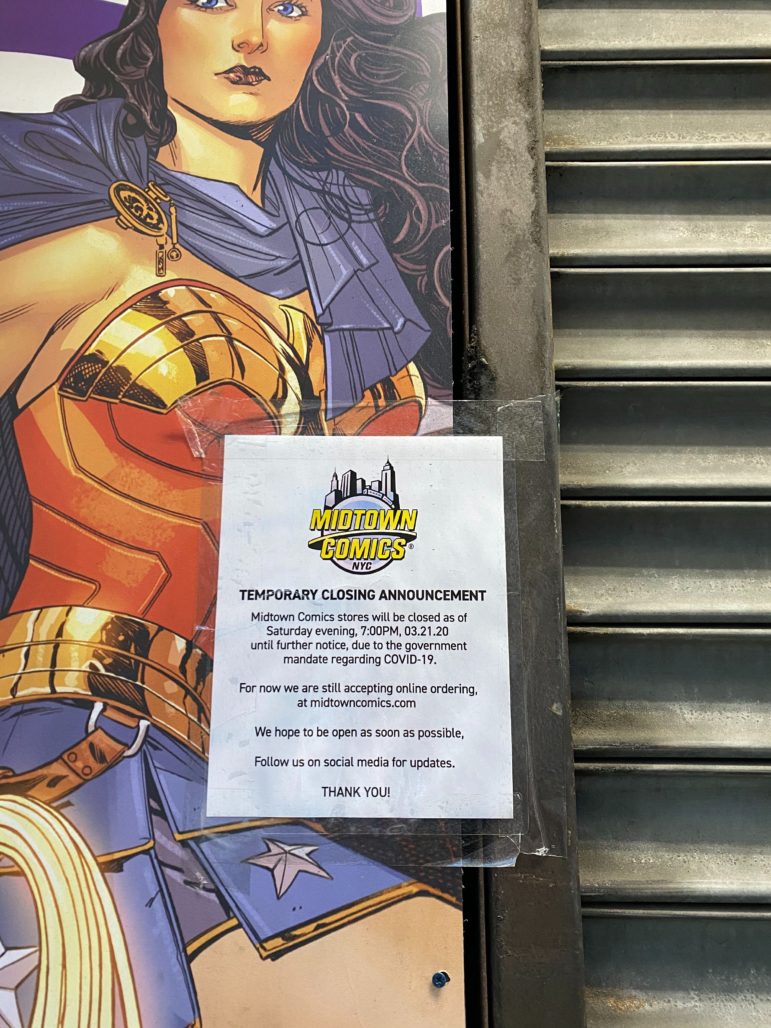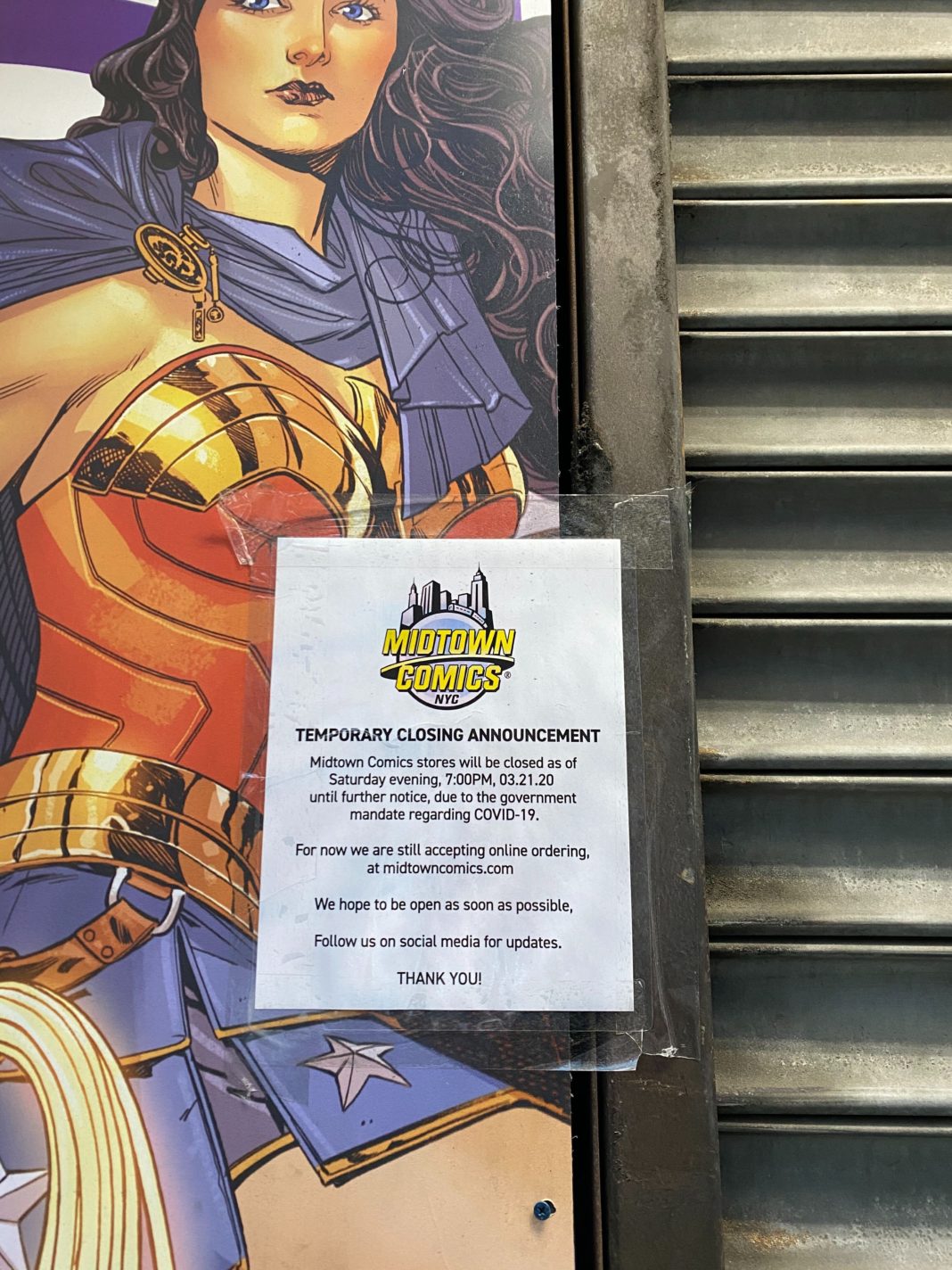New Comic Book Day — the weekly release of dozens of comics that happens each Wednesday, barring holiday or occasional natural disaster (and even then) — is cancelled, and will stay cancelled for the foreseeable future.
Yes, almost no new comics were available last Wednesday and few are available today, neither through local retailers nor digital platforms online, marking the first time many readers have experienced such a drought. This came to pass somewhat suddenly too, with days of slow-breaking industry news pushing it to fruition. As such, the decades-long continuing narratives of ubiquitous American icons have been paused with little warning — Spider-Man, Superman, Batman, and so on — speaking to just how thoroughly life in this country has now been upended by the coronavirus pandemic.
There are, of course, far more serious and substantial lenses to view this tragedy through — the horrific news and numbers coming out of New York, for one — but for many of us the world over, weekly release of comic book stories is a tangible and direct barometer of the severity of the virus’ toll.
To that end, today we’re retracing what happened, why, and when, to cause the cessation of comics distribution, with an eye toward industry reaction and what might be coming next.
Why New Comic Book Day is Cancelled

The first disruption was the cons.
C2E2 in Chicago was the first major American show of the year, and it happened relatively unaltered. It could also end up the last show of the year (although everything from July on is still very much in play). Emerald City Comic Con, which was slated to take place two weeks after C2E2, didn’t happen, and it’s just been a cascade of cancelled or postponed cons ever since.
This escalation of measures taken in the wake of the coronavirus within comics — as well as the reactions of fans, pros, and industry types — is almost a direct mirror of how the United States has responded, writ large. In late February, comics people were still gathering in mass, joking about how we’d have to switch from handshakes to fistbumps when we saw old friends. Midway through March, we finally started postponing major events, with a dichotomy of commentary — this was both the right move and a massive disruption.
The second half of March, however, has been all escalation. As shelter in place orders have come down in major cities and across states, non-essential businesses have closed, and this (of course) includes local comic shops. Some have responded by offering curbside pick-up, others by shipping orders in the mail. But the fact is that in the most viable markets in the country, comics can’t easily be sold.
Even amid the wave of shop shutterings, commerce seemed poised to continue for a few days, with publishers taking measures to support local shops, or publicize sales, or just basically ensure they could get by. This was the period from March 11 — the night the NBA shutdown and Tom Hanks announced he had it — to roughly two weeks after.
There was some talk of delaying upcoming titles, but for the most part, on March 18, new comic book day went off as usual. A flashpoint (sorry DC fans) came on March 23, when Diamond Comic Distribution — the lone distributor for North America — announced it would no longer be taking new orders to its warehouse from publishers, and so there would not be new books available for shops finding ways to continue operations.
This set-off a domino effect of release cancellations throughout the industry. Obviously, there would be no new paper comics (aside from the odd outlier). For many publishers, including number three Image, there is literally no other distribution mechanism for shipping product, not even to bookstores. Statements trickled out by the day, with publishers announcing they would not be releasing digital comics either.

Eventually, all eyes landed on Marvel and DC, dual industry leaders (and it’s not close), who wield more power than the rest combined. Rumors and behind-the-scenes reporting abounded, ranging from confirmations of continuing digital product by sales reps in forums to the notion that both publishers were exploring alternate distribution channels.
Still, between Diamond’s initial announcement on March 23 and March 29, neither of the Big 2 made an official announcement of any substance, leading to six days of guesses and speculation.
Could Marvel and DC Have Published Digital Comics?
In short, yes, but that call was not simple.
Complicating the choice around whether to move forward with digital product was the companies’ relationships with the network of small business retailers that have sold their product exclusively for many years (basically my entire life) in the direct market. Tension between comic shop owners and publishers has long existed around digital comics, with shop owners collectively viewing digital comic books as a threat to their livelihoods, by and large.
This tension has kept prices for digital comic books — which for obvious reasons have less production cost — at near the same level as their physical counterparts. Retailers do not want that medium to have a sizable advantage over the one they peddle. So, when Diamond announced it was essentially shutting down, conducting business as usual with digital books was a fraught decision. Retailers were already down, and — never ones to respond holistically well to wide-spanning change — the tenor of discussion among them online was heavy with fear and desperation.
It appears from industry sources that some at both DC and Marvel seriously considered going ahead with digital releases. But the retailer reaction convinced them that it would not be in their best interest. And so New Comic Book Day ended for the near future.
There was perhaps an opportunity for comic books to dominate a stalled entertainment market amid the pandemic, with audiences homebound as the country attempted to stem the rise of the virus. Film and television production had stopped, all sports were cancelled, and even most late-night talk shows were off the air, resorting to gimmicky broadcasts of iPhone footage shot in hosts’ houses. Continuing to publish digitally could have positioned comics as one of the few chances to experience new media (alongside video games and wrestling), while ensuring that some money was potentially still flowing, available to be paid to freelance creators or whoever else.
By the same token, however, the fear was readers who normally bought physical comics would not buy them if they already read them online, devaluing product local shop owners would badly need to sell to get back on their feet whenever a semblance of normalcy returned to the country (and there’s still no clear idea of when that will be). If the shop owners couldn’t return, it was entirely possible that selling weeks of new books online would diminish sales long-term, as would frayed relationships with the retailers responsible for ordering from Marvel and DC.
So, a standoff ensued. Really, it only lasted days, a short enough time one could count it on their hands, but the chaos of the world and the desire to have answers made it seem far longer. It went through a weekend with info evolving almost by the hour. Clarity finally arrived early the morning of March 30.
In the end, first DC and then Marvel announced no new digital comics would be published today. So, Diamond shipped its last Wednesday comics on March 25, and here we sit, unsure how long comics will be on pause.
When Will New Comic Book Day Return?
Perhaps the hardest part of missing new comic book day is the uncertainty. There are a lot of questions surrounding society in the wake of this 100-year pandemic.
Among these questions are plenty within comics: how many stores will have to close? How many publishers will have to reduce or stop operations? Will Diamond return to business? Will Diamond remain the sole avenue for comic book distribution? Will a closer relationship take hold between digital and print comic book sales?
The tenor of discourse among readers, creators, and retailers now is largely one of doom (more so than usual, even), with all of comics finding new ways to say the same things and ask the same questions. Yes, this is very bad for many people. Yes, this might also present a chance for innovation. No, we don’t have so much as an inkling to what the comics business will look like when it returns. Yes, people will always be driven to make stories that combine words with pictures, and other people will always be compelled to buy and collect and love them.
There’s an old saying I’ve heard too many times to count during all of this — never waste a good crisis. There’s a joke to be made about DC here (and another to be made about how king of the crises Dan DiDio sort of dodged a train we didn’t even see coming), but I won’t make it. Instead, I’ll share a silver lining, as saccharine and solipsistic as it may be.
We’re all at home now, writing and reading and drawing and immersing ourselves in the art. And isn’t finding the time and drive to do that the harder part? It’ll take weeks and months and maybe years to sort out how our stories can be monetized anew amid an inevitable global recession, but those stories will be waiting and good comics have a way of living on.









I strongly think you misunderstand the MAIN “complaint” about Digital First: how can print get “caught up” if there are 6-20 weeks of product “in the gap”? How can stores process this amount of material? How could customers possibly pay for it? Under what terms are they being bought (DC promised full returnability), and does ANY of that make any financial sense for stores or publishers? Those are real, math- and process-driven questions that are far FAR larger than “losing customers” (though that is a small concern over the long haul as well)
-B
If it’s 6 weeks of material, slightly accelerate print and slow digital down until it’s caught up. It doesn’t have to all be done at once, do it a pace the infrastructure can manage. Hopefully it’s not 20 weeks of material, because if that’s the case the vast majority of stores have probably gone out of business.
Moot point I guess because it appears the publishers are content to pause new material for now.
Isn’t there a way that the industry as a whole can implement a print on demand service?
Customer (for those who are still working – like me) goes to comic shop store website, order what he likes to read.
Comic stores then e-mail their orders from loyal customers.
Diamond tells publishers to just print just THESE number of copies for READERS.
Get rid of the stupid variant covers.
Diamond receive books from publishers and ships them off to comic book stores.
Comic book store owner then takes shipment home and ships customers order from comfort of home and charges all loyal customers shipping fees.
Everyone happy, except for money grubbing gougers in collector markets.
World safe and fun again.
~
Coat
Comments are closed.